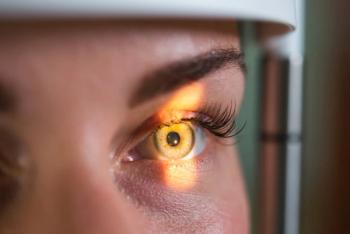
Visual impairment may have a role in dementia, according to a new study
Visual impairment has been consistently identified as a “robust risk factor” in the development of dementia.
A recent cross-sectional study1 found about 19% of dementia prevalence might have resulted from visual impairments that are largely correctable, according to first author Jason R. Smith, ScM, from the Department of Epidemiology and the Cochlear Center for Hearing and Public Health, Johns Hopkins Bloomberg School of Public Health, Baltimore.
He and his colleagues advocated prevention and treatment of visual impairments, ie, distance and near visual acuity and contrast sensitivity, to lower the prevalence rate of dementia.
The investigators explained that because the prevalence rate of dementia is rising global, addressing modifiable risk factors is a priority for preventing the disease.2-4 Visual impairment has been consistently identified as a “robust risk factor” in the development of dementia.5-8 Because vision impairment affects up to 28% of those older than 70 years,9,10 the proportion of dementia resulting from vision impairment might be considerable.
The researchers conducted this population-based cross-sectional analysis in the National Health and Aging Trends Study,11 which gathers nationally representative information in the US on Medicare beneficiaries aged 65 years and older. A total of 2767 community-dwelling adults were included.
The main outcomes were the adjusted population attributable fractions (PAFs) (defined as a measure of how much a risk factor contributes to disease or death in a population) of prevalent dementia, defined using a standardized algorithmic diagnosis (≥1.5 standard deviations below the mean on 1 or more cognitive domains, self- or proxy-reported dementia diagnosis, or the Ascertain Dementia-8 Dementia Screening Interview Score of probable dementia.
Mr. Smith and colleagues reported that the survey-weighted prevalence of vision impairment among participants aged 71 and older was 32.2%. The participants were 54.7% female, 8.0% non-Hispanic Black, 81.7% Hispanic, 81.7% non-Hispanic White, and 3.3% non-Hispanic other.
“The PAF of prevalent dementia from at least 1 vision impairment was 19.0% (95% confidence interval [CI], 8.2-29.7). Contrast sensitivity impairment yielded the strongest attributable fraction among all impairments (15.0%; 95% CI, 6.6-23.6), followed by near acuity (9.7%; 95% CI, 2.6-17.0), and distance acuity (4.9%; 95% CI, 0.1-9.9). PAFs from at least 1 visual impairment were highest among participants aged 71 to 79 years (24.3%; 95% CI, 6.6-41.8), female (26.8%; 95% CI, 12.2-39.9), and non-Hispanic White (22.3%; 95% CI, 9.6-34.5) subpopulations, with estimates consistent across educational strata,” the authors reported.
They commented that the PAFs of dementia from vision impairments ranged from 4.9% to 19.0%; however, although this is not a cause-and-effect relationship, “these findings support inclusion of multiple objective measures of vision impairments, including contrast sensitivity and visual acuity, to capture the total potential impact of addressing vision impairment on dementia.”
Because contrast sensitivity was associated with the largest PAF, this indicated that the total impact of vision impairment on dementia should be quantified using measures beyond just distance visual acuity.
References:
Smith JR, Huang AR, Zhou Y, et al. Vision Impairment and the Population Attributable Fraction of Dementia in Older Adults. JAMA Ophthalmol. 2024;142:900-908; doi:10.1001/jamaophthalmol.2024.3131
US Department of Health and Human Services. National plan to address Alzheimer’s disease: 2021 update. Accessed April 10, 2023.
https://aspe.hhs.gov/sites/default/files/documents/66904c18bb1f0843c3c113d7099e98c1/napa-national-plan-2021-update.pdf Livingston G, Huntley J, Sommerlad A, et al. Dementia prevention, intervention, and care: 2020 report of the Lancet Commission. Lancet. 2020;396(10248):413-446. doi:
10.1016/S0140-6736(20)30367-6 National Academies of Sciences E. Medicine. Preventing cognitive decline and dementia: a way forward. The National Academies Press; 2017.
Kuźma E, Littlejohns TJ, Khawaja AP, Llewellyn DJ, Ukoumunne OC, Thiem U. Visual impairment, eye diseases, and dementia risk: a systematic review and meta-analysis. J Alzheimers Dis. 2021;83:1073-1087. doi:
10.3233/JAD-210250 Shang X, Zhu Z, Wang W, Ha J, He M. The association between vision impairment and incidence of dementia and cognitive impairment: a systematic review and meta-analysis. Ophthalmology. 2021;128:1135-1149. doi:
10.1016/j.ophtha.2020.12.029 Nagarajan N, Assi L, Varadaraj V, et al. Vision impairment and cognitive decline among older adults: a systematic review. BMJ Open. 2022;12:e047929. doi:
10.1136/bmjopen-2020-047929 Burton MJ, Ramke J, Marques AP, et al. The Lancet Global Health Commission on Global Eye Health: vision beyond 2020. Lancet Glob Health. 2021;9::e489-e551. doi:
10.1016/S2214-109X(20)30488-5 Flaxman AD, Wittenborn JS, Robalik T, et al; Vision and Eye Health Surveillance System study group. Prevalence of visual acuity loss or blindness in the US: a Bayesian meta-analysis. JAMA Ophthalmol. 2021;139:717-723. doi:
10.1001/jamaophthalmol.2021.0527 Killeen OJ, De Lott LB, Zhou Y, et al. Population prevalence of vision impairment in US adults 71 years and older: the National Health and Aging Trends Study. JAMA Ophthalmol. 2023;141:197-204. doi:
10.1001/jamaophthalmol.2022.5840 Freedman VA, Kasper JD. Cohort profile: the National Health and Aging Trends Study (NHATS). Int J Epidemiol. 2019;48:1044-1045g. doi:
10.1093/ije/dyz109
Newsletter
Want more insights like this? Subscribe to Optometry Times and get clinical pearls and practice tips delivered straight to your inbox.








































